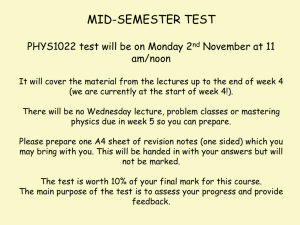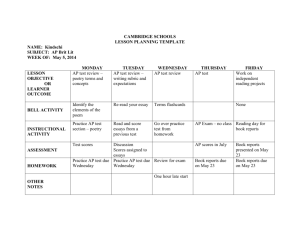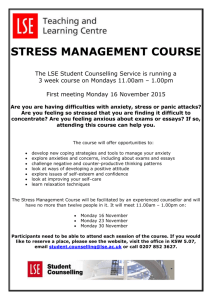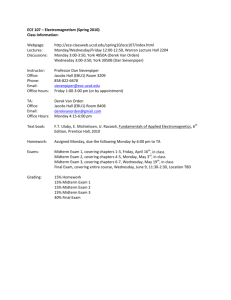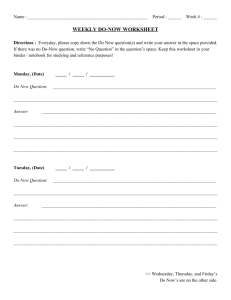Religion in the American South Dr. John Hayes
advertisement
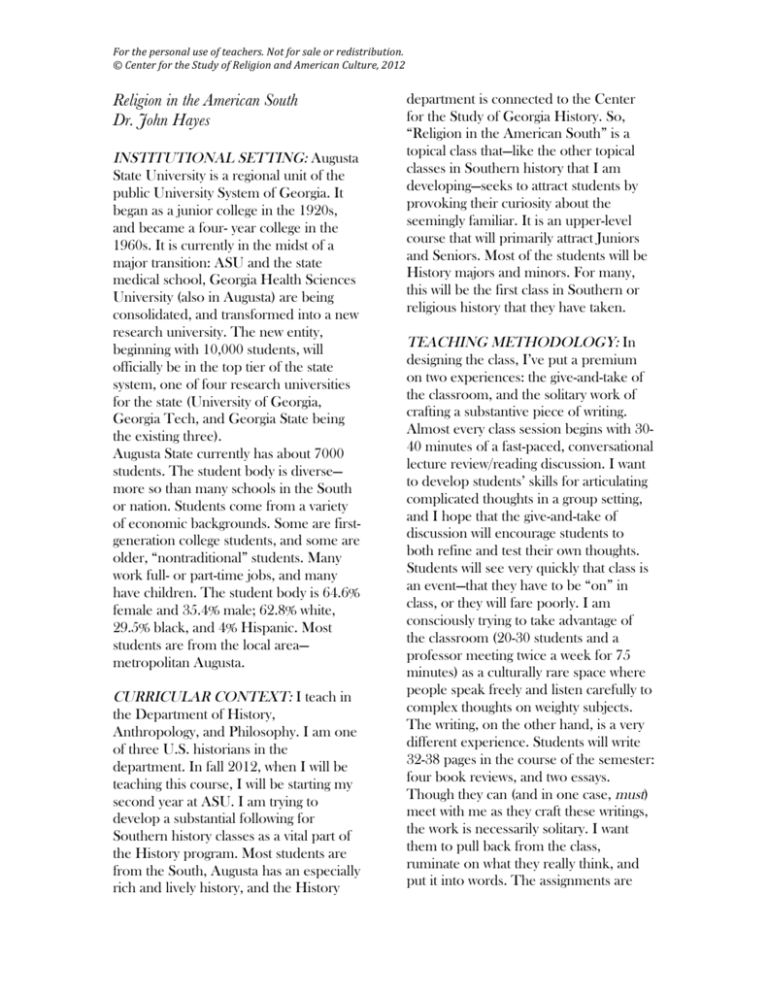
For the personal use of teachers. Not for sale or redistribution. © Center for the Study of Religion and American Culture, 2012 Religion in the American South Dr. John Hayes INSTITUTIONAL SETTING: Augusta State University is a regional unit of the public University System of Georgia. It began as a junior college in the 1920s, and became a four- year college in the 1960s. It is currently in the midst of a major transition: ASU and the state medical school, Georgia Health Sciences University (also in Augusta) are being consolidated, and transformed into a new research university. The new entity, beginning with 10,000 students, will officially be in the top tier of the state system, one of four research universities for the state (University of Georgia, Georgia Tech, and Georgia State being the existing three). Augusta State currently has about 7000 students. The student body is diverse— more so than many schools in the South or nation. Students come from a variety of economic backgrounds. Some are firstgeneration college students, and some are older, “nontraditional” students. Many work full- or part-time jobs, and many have children. The student body is 64.6% female and 35.4% male; 62.8% white, 29.5% black, and 4% Hispanic. Most students are from the local area— metropolitan Augusta. CURRICULAR CONTEXT: I teach in the Department of History, Anthropology, and Philosophy. I am one of three U.S. historians in the department. In fall 2012, when I will be teaching this course, I will be starting my second year at ASU. I am trying to develop a substantial following for Southern history classes as a vital part of the History program. Most students are from the South, Augusta has an especially rich and lively history, and the History department is connected to the Center for the Study of Georgia History. So, “Religion in the American South” is a topical class that—like the other topical classes in Southern history that I am developing—seeks to attract students by provoking their curiosity about the seemingly familiar. It is an upper-level course that will primarily attract Juniors and Seniors. Most of the students will be History majors and minors. For many, this will be the first class in Southern or religious history that they have taken. TEACHING METHODOLOGY: In designing the class, I’ve put a premium on two experiences: the give-and-take of the classroom, and the solitary work of crafting a substantive piece of writing. Almost every class session begins with 3040 minutes of a fast-paced, conversational lecture review/reading discussion. I want to develop students’ skills for articulating complicated thoughts in a group setting, and I hope that the give-and-take of discussion will encourage students to both refine and test their own thoughts. Students will see very quickly that class is an event—that they have to be “on” in class, or they will fare poorly. I am consciously trying to take advantage of the classroom (20-30 students and a professor meeting twice a week for 75 minutes) as a culturally rare space where people speak freely and listen carefully to complex thoughts on weighty subjects. The writing, on the other hand, is a very different experience. Students will write 32-38 pages in the course of the semester: four book reviews, and two essays. Though they can (and in one case, must) meet with me as they craft these writings, the work is necessarily solitary. I want them to pull back from the class, ruminate on what they really think, and put it into words. The assignments are For the personal use of teachers. Not for sale or redistribution. © Center for the Study of Religion and American Culture, 2012 spaced out sufficiently for students to learn from their previous graded work, and they have ample time (in the case of the essays, a week) to compose substantive writing. Both book reviews and essays are set up so that students think analytically and historically about religion—making careful observations as they craft a coherent narrative. For the personal use of teachers. Not for sale or redistribution. © Center for the Study of Religion and American Culture, 2012 History 4950B/6950B Religion in the American South MW 5:30-6:45, Allgood E257 Dr. John Hayes jhayes22@aug.edu, 706-248-3391 Office: Allgood E209 Office hours: MWF 11-12 or by apt. The “Bible Belt;” roadside signs warning Repent! or admonishing Pray; “In God We Trust” on license plates; prayers before athletic events; more church buildings than you can count; everyday conversation touching on matters of faith and belief—the American South seems, inarguably, to be a society marked by religion. But what religion, exactly? The same religion over four centuries? Different religions? Different forms of the same religion? Was the South always as religious as it may seem to us today? Has religiosity waxed, waned, remained static, or veered up and down over time? With different religious groups as the main characters, this class tells a winding story of the diverse ways in which people have religiously imagined life in the American South. How did they understand the relation between the sacred and society? What did they picture as the ideal way of life? What rituals did they practice to codify this ideal, and who was included in these rituals? Was their religious vision a sacred alternative to the dominant culture, or did they seek to craft a sacralized society? In pursuing these questions in a narrative format, we will learn that religion in the South has been neither homogenous nor unchanging. Different groups have waxed and waned in cultural power, and different visions of the sacred have been imagined in changing contexts. The story of these groups and these changing visions is the story of religion in the American South. CLASS FORMAT: With the exception of the 1st week and midterm, each class session is divided into 3 parts: 1) a 10-15 minute critical review of the previous session’s lecture; 2) a 20-25 minute discussion of the reading for that session; 3) a 35-45 minute lecture on new material. In the first 2 parts, you need to be ready to talk critically about the previous lecture and the new reading. Review your notes on the most recent lecture, and carefully read the assigned chapter. Then, use the Lecture Review and Chapter Review guides (last page of syllabus) to prepare for class discussion. In part 3, be ready to listen carefully and critically to new material. The lectures give a broad view, while the books zoom in on specific For the personal use of teachers. Not for sale or redistribution. © Center for the Study of Religion and American Culture, 2012 subjects—what you will hear in lecture will only roughly overlap with the books, so engage closely with the lecture to get the larger narrative. LEARNING OBJECTIVES: 1) Students will gain a clear grasp of the basic story of religion in the American South: the major characters, their distinct characteristics, their changing status, and major events/turning points in the story. This narrative is primarily developed in class lectures, though the books will supplement it a certain points. Students will regularly review the lectures, and be assessed on their understanding in part 1 of each class session. The two exams test knowledge of the content that is necessary to craft the story, while the two essays are the primary vehicle to display a clear grasp of the narrative arc of the individual lectures. 2) Students will develop interpretive skills to make sense of religion in the past, and in the world that they see around them. Both books and lectures will illustrate techniques for understanding religion—how to get precise on often fuzzy matters of belief and practice. This involves learning viable categories, drawing comparisons between different phenomena, and developing an interpretive vocabulary. Students will refine their interpretive skills in the give-and-take of class discussion, and both the essays and book reviews will allow for more considered, conscious use of the skills. 3) Students will engage with books as irreducible, coherent works that tell us things that cannot be told any other way. With the technology developed in the last several decades, we have an infinite amount of information readily available to us—but overwhelmingly as pieces and fragments. Through rigorous reading of 4 historical monographs and 1 novel, this class argues for the importance of books as longer entities that tell a coherent story and/or offer sustained analysis of complicated phenomena. Students will wrestle with each book as they read it slowly, discuss it at length in class, and then write a critical review. REQUIRED BOOKS: Christine Heyrman, Southern Cross: The Beginnings of the Bible Belt Charles Marsh, God’s Long Summer: Stories of Faith and Civil Rights Flannery O’Connor, Wise Blood Mechal Sobel, Trabelin On: The Slave Journey to an Afro-Baptist Faith Randall Stephens, The Fire Spreads: Holiness and Pentecostalism in the American South All books are available in the ASU bookstore. You are also welcome to look for cheaper copies online. Any edition of any of the books is fine—but you must have a hard copy of the book, when we are reading it. Make notes in the book, and bring it to class with you on the days that we are discussing it. GRADES: Class participation (parts 1 and 2 of every class session): 15% Exams (a midterm and a final, focusing on lecture content): 12.5% each (25% total) Reviews (a review of each of the 4 historical monographs): 7.5% each (30% total) Essays (a midterm and a final; lecture narrative and analysis): 15% each (30% total) Both exams are 100 questions in multiple-choice format. Each book review should be 1200-1500 words (4-5 pages double-spaced). Each essay should be 2400-2700 words (8-9 pages). Any review or essay that is too short will receive an automatic F. For the personal use of teachers. Not for sale or redistribution. © Center for the Study of Religion and American Culture, 2012 CLASS MECHANICS: 1) Syllabus: Bring this syllabus to class with you every day. We will consult it often. 2) Attendance: Attendance is mandatory. You are allowed three absences without penalty. These allowed absences include minor illness, accidents, prior commitments, and the like. You do not need to explain why you missed class. Each absence over three results in three points subtracted from your final grade. In the event of a more serious issue—a death in the family, a major illness, etc—let me know, and the policy will be altered. Whenever you miss class, though, it is up to you to find out what you missed. 3) Class Participation: Vocal, engaged participation in class sessions is critical to doing well in the class. In the first 2 parts of class, you need to speak up and articulate your thoughts. Overall class participation will be based on how many class sessions you meaningfully participated in: over 75% (A), 50-75% (B), 25-50% (C), 1-25% (D), none (F). Don’t let normal shyness get the better of you. Learn to say what you think in a group setting— even when we are discussing controversial and emotionally weighty subjects. 4) Note-taking: Taking good notes is critical to doing well in the class. There is no overarching textbook, and the readings are a compliment to the lectures, not a substitute. When the lecture phase of class begins, be ready to listen carefully and write in your notes. At any point in the lecture, feel free to ask a question, make a critique, or request fuller explanation of the topic. 5) Reading: We are reading five books. You need to read closely and carefully, and be ready to talk about it. Mark in the books, bring them on the days we are discussing them, and have them available to refer to in class discussion. The discussion will move from large questions about the reading, to much more nuanced ones, so do not merely skim the reading for highlights. You will also use the books as you craft your reviews. Having read the book carefully before the assignment will insure a quality review. 6) Book Reviews and Essays: You will write four book reviews and two essays for the class. They are all open-note, open-book, to be crafted outside the classroom. Book reviews should be 4-5 pages, and essays should be 8-9 pages. I will give specific questions for each of these assignments as they approach. Neither book reviews nor essays are research papers: craft them based on what you have read, or what you have listened to in class— not extraneous material. Book reviews and essays are due as hard copies in my office or department mailbox. However, since all of these except one are due on Fridays, you may email a copy if you are not otherwise on campus on Friday. 7) Exams: There are two exams for the class, a midterm and a final. They cover content from the lectures—the concrete details of the story the class is telling. They are not cumulative. Note that 2 book reviews count for more than 1 exam: the exams are important, but they are only a part (1/4) of your overall grade. 8) Email and Desire 2 Learn: Be in the habit of checking your ASU email account on a regular basis: unforeseen announcements and slight syllabus modifications may be communicated by email. On the class D2L site, you will find all of the images seen in class. Use these, along with your notes, as you study for the exams and write your essays. 9) Office Hours/Meetings: During midterm week, you are required to meet with me as you work on your first essay. But, I encourage you to come by my office as often as you would like—to talk about subject-matter from the class, life at ASU, the sacred ritual of SEC football, the liturgy of barbeque, the paradoxes of the South, and other matters. I am in the office MWF from 11-12, but I am happy to schedule meetings at other times if that block doesn’t work for you. The office has a large shrine to St. Johnny Cash, relics For the personal use of teachers. Not for sale or redistribution. © Center for the Study of Religion and American Culture, 2012 associated with Flannery O’Connor and the Rev. Dr. Martin Luther King, an archaic but surprisingly comfortable rocking chair, and a variety of Southern kitsch. SCHEDULE OF CLASSES: I. Introduction Monday 8/20 review Syllabus; Getting Started; Your Context Wednesday 8/22 discuss O’Connor, Wise Blood chs1-3; review Thinking Historically About Religion and the South II. From Colonial Beginnings to Confederate Nation Monday 8/27 discuss Sobel, Trabelin’ On ch1; lecture: Transplanting English Religion Wednesday 8/29 discuss: Sobel, Trabelin’ On ch2; lecture: Inside the Anglican Parish Wednesday 9/5 discuss Sobel, Trabelin’ On ch3; lecture: Anglican/Native American Religious Encounters Monday 9/10 discuss Sobel, Trabelin’ On ch4; lecture: Imagining Race Wednesday 9/12 discuss Sobel, Trabelin’ On ch5; lecture: Toleration and Dissenters Monday 9/17 discuss Sobel, Trabelin’ On ch6; lecture: Evangelical Beginnings Wednesday 9/19 dicuss Sobel, Trabelin’ On ch7; lecture: The Enlightenment and Freedom of Religion Friday 9/21 Review of Trabelin On’ due by noon Monday 9/24 discuss Heyrman, Southern Cross ch1; lecture: Catholics and Regional Expansion Wednesday 9/26 discuss Heyrman, Southern Cross ch2; lecture: Regional Religious Divisions Monday 10/1 discuss Heyrman, Southern Cross ch3; lecture: Slave Resistance and Rebellion Wednesday 10/3 discuss Heyrman, Southern Cross ch4; lecture: Christianizing Mastery: Paternalism Monday 10/8 discuss Heyrman, Southern Cross ch5; lecture: Sacralizing the Confederacy Wednesday 10/10 lecture: Emancipation as Jubilee; Review of Southern Cross due III. Midterm Assessment Monday 10/15 Midterm Exam Wednesday 10/17 Meet with me to discuss your essay-in-the-works Friday 10/19 Midterm Essay due by noon IV. From New South to Sun Belt Wednesday 10/24 discuss Stephens, The Fire Spreads ch1; lecture: Reconstructing Black and White Churches Monday 10/29 discuss Stephens, The Fire Spreads ch2; lecture: Evangelical Ascendancy For the personal use of teachers. Not for sale or redistribution. © Center for the Study of Religion and American Culture, 2012 Wednesday 10/31 discuss Stephens, The Fire Spreads ch3; lecture: Inside the Bible Belt Monday 11/5 discuss Stephens, The Fire Spreads ch4; lecture: Purity, Respectability, Segregation Wednesday 11/7 discuss Stephens, The Fire Spreads ch5; lecture: Closing Ranks: Evangelical Hegemony Friday 11/9 Review of The Fire Spreads due by noon Monday 11/12 discuss Marsh, God’s Long Summer introduction, ch1; lecture: Folk Christians Wednesday 11/14 discuss Marsh, God’s Long Summer ch2; lecture: Fundamentalism and the Image of the South Monday 11/19 discuss Marsh, God’s Long Summer ch3; lecture: Sacralizing the American Nation Monday 11/26 discuss Marsh, God’s Long Summer ch4; lecture: The Rise of NeoEvangelicalism Wednesday 11/28 discuss Marsh, God’s Long Summer ch5, conclusion, afterword; lecture: New Migrants, Old Religions Friday 11/30 Review of God’s Long Summer due by noon Monday 12/3 discuss O’Connor, Wise Blood chs4-6; lecture: Spirituality and New Religious Currents Wednesday 12/5 discuss O’Connor, Wise Blood chs7-10; lecture: The Religious Right Monday 12/10 discuss O’Connor, Wise Blood chs11-14; review Thinking Historically About Religion and the South, Round 2 Friday 12/14 Final Exam 6pm Monday 12/17 Final Essay due by noon LECTURE/CHAPTER REVIEW GUIDE: • • • • • • • • What was the main subject—what was the lecture/chapter about? Where in the South—what is the setting? When? What is the time frame? What was the main point the professor/author was trying to make? Note 3 specific places/illustrations that capture that point. What are key words that recur throughout the lecture/chapter? What did not make sense (a word, phrase, paragraph, illustration)? What did you disagree with? For the personal use of teachers. Not for sale or redistribution. © Center for the Study of Religion and American Culture, 2012


